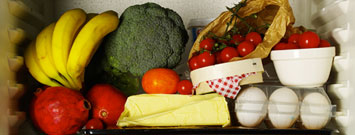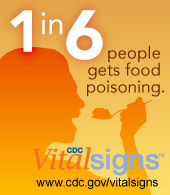Salmonella is a Sneaky Germ: Seven Tips for Safer Eating
 Salmonella can contaminate more than poultry and eggs. It sneaks its way into many foods— ground beef, pork, tomatoes, sprouts—even peanut butter. Learn what you can do to make your food safer to eat.
Salmonella can contaminate more than poultry and eggs. It sneaks its way into many foods— ground beef, pork, tomatoes, sprouts—even peanut butter. Learn what you can do to make your food safer to eat.
 Salmonella is a bacteria and a common cause of foodborne illness, sometimes called "food poisoning." In the past few years, large outbreaks of illness caused by Salmonella-contaminated eggs and peanut products have made the headlines. Although many other foodborne illnesses have declined in the past 15 years, Salmonella infections have not declined at all. A new Vital Signs report on making our food safer to eat focuses on reducing contamination from Salmonella.
Salmonella is a bacteria and a common cause of foodborne illness, sometimes called "food poisoning." In the past few years, large outbreaks of illness caused by Salmonella-contaminated eggs and peanut products have made the headlines. Although many other foodborne illnesses have declined in the past 15 years, Salmonella infections have not declined at all. A new Vital Signs report on making our food safer to eat focuses on reducing contamination from Salmonella.
Don't let Salmonella sneak up on you. Seven facts that may surprise you—know the risks.
- You can get Salmonella from eating a wide variety of foods, not just from eggs and undercooked poultry. Although poultry and eggs are primary culprits, Salmonella can be found in a variety of foods including ground meat, fruits, vegetables—even processed foods such as frozen pot pies.
 Salmonella illness can sometimes be serious. In most cases, illness lasts 4–7 days, and most people recover without antibiotic treatment. But, in rare cases, people may become seriously ill. Compared with other foodborne germs, Salmonella is the deadliest. It also causes more hospitalizations as well.
Salmonella illness can sometimes be serious. In most cases, illness lasts 4–7 days, and most people recover without antibiotic treatment. But, in rare cases, people may become seriously ill. Compared with other foodborne germs, Salmonella is the deadliest. It also causes more hospitalizations as well.- For every 1 case of Salmonella illness that is confirmed in the laboratory, there are about 30 times more cases of Salmonella illnesses that were not confirmed.
Most people who get food poisoning usually do not go the doctor, and therefore don't get laboratory confirmation of exactly what made them sick. So Salmonella can cause more illness than you might suspect. - Salmonella illness is more common in the summer.
Warmer weather gives bacteria more opportunity to contaminate food. When eating outdoors in the summer, either in the backyard or on a picnic, follow these guidelines:- Always keep cold foods cold and hot foods hot.
- When you're finished eating, refrigerate leftovers promptly. Don't let food sit out for more than 2 hours. On a hot day (90°F or higher), reduce this time to 1 hour.
- Be sure to put perishable items in a cooler or insulated bag.
 You can get Salmonella from perfectly normal-looking eggs.
You can get Salmonella from perfectly normal-looking eggs.
Chicken feces on the outside of egg shells used to be a common cause of Salmonella contamination. To counter that, stringent procedures for cleaning and inspecting eggs were implemented in the 1970s. However, now there's a new cause for concern. An epidemic that started in the 1980s and continues today is due to a type of Salmonella that is inside intact grade A eggs with clean shells. This type of Salmonella can silently infect the ovaries of healthy appearing hens and contaminate the inside of eggs before the shells are formed.- To avoid Salmonella, you should never eat raw or lightly cooked (runny whites or yolks) eggs.
Cooking reduces the number of Salmonella bacteria present in an egg. However, a lightly cooked egg with a runny egg white or yolk still poses a greater risk than a thoroughly cooked egg. Lightly cooked egg whites and yolks have both caused outbreaks of Salmonella infections. - Salmonella is more dangerous for certain people.
Although anyone can get a Salmonella infection, older adults, infants, and people with impaired immune systems are at increased risk for serious illness. In these people, a relatively small number of Salmonella bacteria can cause severe illness.
 You can keep you and your family safer by remembering to:
You can keep you and your family safer by remembering to:
- Clean. Wash hands, cutting boards, utensils, and countertops.
- Separate. Keep raw meat, poultry, and seafood separate from ready-to-eat foods.
- Cook. Use a food thermometer to ensure that foods are cooked to a safe internal temperature: 145°F for whole meats (allowing the meat to rest for 3 minutes before carving or consuming), 160°F for ground meats, and 165°F for all poultry.
- Chill. Keep your refrigerator below 40°F and refrigerate food that will spoil.
- Don't prepare food for others if you have diarrhea or vomiting.
- Be especially careful preparing food for children, pregnant woman, those in poor health, and older adults.
More Information
Get email updates
To receive email updates about this page, enter your email address:
Contact Us:
- Centers for Disease Control and Prevention
1600 Clifton Rd
Atlanta, GA 30333 - 800-CDC-INFO
(800-232-4636)
TTY: (888) 232-6348 - Contact CDC-INFO




